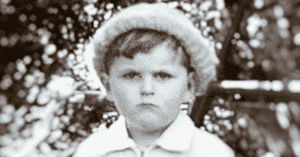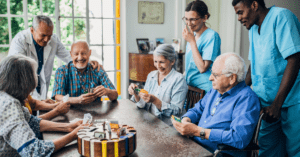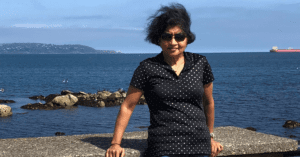There are two main categories of human clinical trials: (1) observational studies, and 2) interventional studies. Both types of clinical studies are essential to developing new therapies for rare diseases like Ataxia. There are multiple trials taking place right now for Ataxia. In this PrepRARE article, learn a little more about these two types of studies and hear first-hand from two of our members about their personal experience participating in clinical trials.
Observational Studies
In an observational study, information is collected by investigators by observing or measuring how specific characteristics or outcomes change in study participants over time. However, no attempt is made throughout the trial to interfere or change any outcomes that are measured. When it comes to Ataxia, natural history studies are the most common type of observational study.
What is a natural history study and why are they important?
A natural history study collects data and biological samples to learn how a specific disease progresses in individuals over time. Natural history studies are essential for understanding the clinical symptoms that patients experience over time and for designing effective clinical trials to accelerate drug development. They can also help identify factors that may increase or slow disease progression in certain individuals, such as age, environmental factors, or even genetics.
What does participation in a natural history study entail?
Participation in an Ataxia natural history study typically requires individuals to attend multiple appointments with an Ataxia clinician at specific clinical trial sites. At these appointments, participants undergo a number of physical and written tests. There may be more intensive procedures involved, such as MRI imaging, blood draws, and collection of cerebral spinal fluid through a spinal tap. The data and samples collected at these appointments are safely stored in databases and biorepositories with all identifiable information removed, such as the names and contact information of study participants. This ‘de-identified’ data and biosamples are often required to be made available to Ataxia researchers for approved research studies.
Read NAF member Hannah Xu’s story below about her experience participating in two Ataxia natural history studies at the same time. One of these studies, called the Clinical Research Consortium for the Study of Cerebellar Ataxia (CRC-SCA), is sponsored by NAF with help from the Macklin Foundation and NAF’s Drug Development Collaborative. This study is actively recruiting participants that have SCAs type 1, 2, 3, 6, and 7 (and SCA 8 and 10 at some locations) at 10 sites around the country. To learn more about how to participate you can visit the NAF website here.
Hannah Xu: My Ataxia Story
My name is Hannah, and I live in California with my husband and 9-year-old son. In 2012, when I was about 36, I gave birth to my son. After a few months breastfeeding, I decided to give myself a break and went for a vacation in Europe with a friend.
We did lots of walking and up/down buses in Europe. My friend who had not seen me for a long time pointed out my balance problem. At that time, my balance problem was not very noticeable, and she suggested I get it checked. Nobody thought it would be a big deal as we all suspected I might have issues with my ears.
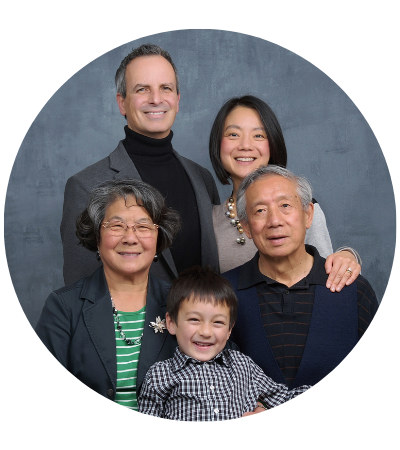
My doctor referred me to a specialist, and, after a few tests, I was diagnosed with SCA1. Not much information was available in 2013, so I did my own research plus reviewed the diagnosing documents my insurance company provided to learned what SCA is. I am sure I inherited it from my father who was not diagnosed at that time but had the tendency of falling for many years. As you can imagine, I went through the phases of being angry, denial, then….
I decided to join the local support group as well as the National Ataxia Foundation. I came across many fantastic people in the group who are affected by Ataxia, who never stop fighting and always support each other.
One thing I feel good about is my motivation to participate in studies by NAF or other institutes such as UCSF (the University of California, San Francisco). Ataxia is a rare disease, and although we don’t have a cure today, with efforts from both patients and doctors, we will cure the disease in the future.
I am currently participating in two studies: READISCA and CRC-SCA, which are two different Natural History Studies of Ataxia. Both studies are similar and easy to navigate. The coordinator I work with is making sure the overlap portion of the two studies is handled efficiently so I don’t need to do the same thing twice.
Each visit usually takes 3 to 4 hours, starting with filling out some forms. I then do several doctor’s observation tests, provide information on questionnaires, and end the appointment with a blood draw. I opted out of two assessments, the MRI and lumbar puncture, for personal reasons.
My overall experience is very positive, and I am looking forward to my next visit
Interventional Studies
Interventional studies are what most people typically think of when we hear “clinical trial.” As the name suggests, interventional studies involve testing some type of intervention, such as a potential drug, medical device, activity, or procedure, in people and observing its effects over time. For Ataxias, most interventional studies aim to determine whether a new treatment is slowing disease or improving patient symptoms.
Phases of an Interventional Study
There are four phases of interventional clinical trials. In Phase 1, the investigational treatment is given to a small group of individuals (~10-20) with the primary goal of determining whether it is safe in people. If a treatment is deemed safe in Phase 1, it may then move into Phase 2 where it will be given to a slightly larger group of trial participants (around 10-100). Here researchers continue to learn about potential drug side effects, safety, and dosing, but also begin evaluating whether the intervention is causing the intended health benefit for participants. Phase 3 clinical trials determine in an even larger group of people (100+) whether the drug or intervention is working as intended. It can take up to a decade or beyond for a drug to make its way through the Phases 1 through 3.
Only after Phase 3 is complete, can the drug company sponsoring the clinical trial submit what is called a New Drug Application (NDA) to the FDA. The FDA evaluates all clinical trial data and other supporting information enclosed in the NDA to determine whether the studies have really proven that the drug is safe and effective in patients. NDA approval by the FDA is required for a company to commercialize the drug or intervention, meaning it cannot be made available to patients across the US until NDA approval. Phase 4 clinical trials occur after a drug is approved, and involves the continued evaluation of safety, side effects, and efficacy of the drug in the general population.
In the featured story below, Lucy Lin discusses her Ataxia diagnosis and experience participating in Biohaven Pharmaceutical’s Phase 3 clinical trial of the investigational drug Troriluzole. This Phase 3 trial is ongoing, but top-level results of this study were released in May 2022. You can find Biohaven’s press release here.
Lucy Lin: Two Years in for a Lifetime of Ataxia
My Diagnosis
I am not a very sharp person, nor were my parents, when it comes to sniffing out symptoms that could lead to a diagnosis. As a child, I was as clumsy as you can get. I was reserved and not loud. Clumsiness and shyness don’t mix well for sports. The only fervent participation in physical education in my youth came as a result of an unrequited high school crush.
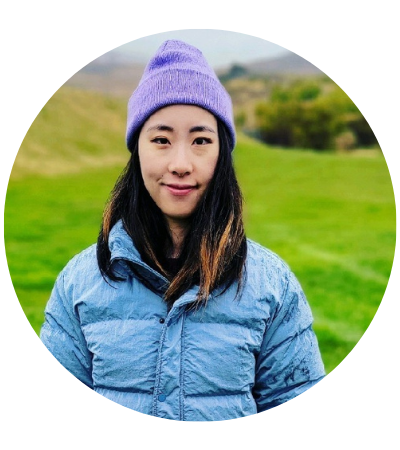
What accelerated my road to the diagnosis was meeting a sharp and inquisitive boyfriend, who’s now my dear partner. I met Anthony before I turned 21. From seeing me falling into a bush on our third date, to then finding me unable to even stand up from my snowboard despite best efforts, he quickly gathered that something was wrong. This got me to see a neurologist.
With a clear family history of imbalance issues (my grandmother, mother and all her siblings), indication of shrinkage in the cerebellum from an MRI, and a final blood test that confirmed the expanded repeat number, my neurologist had clear evidence to diagnose me with SCA Type 3. It was 4 years from the snowboarding trip, where there were clear signs of my symptoms, to receive a genetic diagnosis at age 25.
Process of enrolling in the trial
I am lucky to be in the US, because there is an abundance of clinical trials for a rare disease like Ataxia. I was diagnosed just before the pandemic, so there was a delay of 9 months search for a clinical trial. I found out about the Trorilozule study, sponsored by Biohaven Pharmaceuticals, after a quick Google search. After getting connected with the study coordinator and discussing qualifications, the study site flew me to Long Beach in Los Angeles for a preliminary examination to make sure it would be safe and productive for me to be in the study. That was January 2021, and hence started my tri-monthly flight to Los Angeles for a medical adventure.
Reflection: How is it going
I vividly remember my first visit. I was very excited to connect with the study team and find out how they were going to study me over the next couple of years. Every time it is roughly the same routine. I provide a urine sample as I walk in. They film me walking, standing, and talking to compare progress across my study duration. This is followed by a series of questionnaires about mood, health, and quality of life. Then I get a SARA (Scale for the Assessment and Rating of Ataxia) exam from a neurologist, and a blood draw from a nurse. This completes my study session. Today, I’m in my second year of study, after completing about 10 trips to Los Angeles.
The best part about being studied by someone else is that you will naturally gain symptom awareness. The idea that someone is monitoring your health outcomes is going to motivate you to take care of yourself. That’s what it did for me.
Enrolling in a clinical trial has:
- Encouraged me to pay attention to my symptoms and my progression.
- Created heightened self-awareness to do daily “work” on my symptoms (vitamins, diet, exercises and speech practice).
- Elicited a positive outlook in me because I’m proactively seeking treatment for me and helping move the science forward for others like me.
- Allowed me to appreciate the medical care providers and researchers who are helping people like me find a treatment or cure.
Over the last 2 years, I’ve gained a better understanding of what I can and cannot do. It’s still evolving every day. Every day, I try to play out the best possible scenario with Ataxia. Ataxia has made me tougher in some ways, and more frail in others. I know it’s going to be a hard and long journey for the rest of my life. I’m just getting started. But I’m grateful to have clinical trials to help us peer into, understand, and hopefully solve the mystery of our brain.


